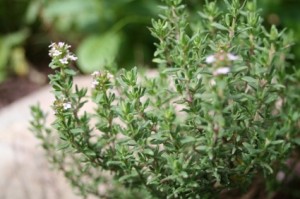 Thyme is a very aromatic herb commonly used for both cooking and in natural medicines. It has a very wide range of uses and abilities.
Thyme is a very aromatic herb commonly used for both cooking and in natural medicines. It has a very wide range of uses and abilities.
The origin of the name “thyme” is said to be from the Greek word thymus, which means “courage.” However, to the Greeks it had a dual meaning—“to fumigate.” Thyme, which has been widely grown in both Europe and the U.S., was grown originally in the Mediterranean region. It came to North America with the first colonists, being used primarily as a food preservative and for medical relief in many ailments.
Down through the centuries it has been used for various ailments, from melancholia to epileptic seizures. In ancient times thyme was one of the first herbs sued as incense. It was often mixed with equal parts of lavender and sprinkled on the floors of churches in the Middle Ages to eliminate any unwanted odors. In ancient Egypt, thyme was one of the ingredients used in the mummification process. It has also been used as a perfume among some ancient cultures.
In recent years it has been prescribed by herbalists for intestinal worms, gastrointestinal ailments, bronchial problems, lack of appetite, diarrhea, menstrual cramps, the common cold, and laryngitis. In Germany it is used to treat whooping cough and emphysema.
Thyme has antiseptic qualities that make it useful for a mouthwash and to combat tooth decay. Its antiseptic qualities also make it useful in cases of anemia, bronchial ailments, and intestinal problems, as well as a skin cleanser. It has been known for anti-fungal properties that can be used to treat athlete’s foot and has anti-parasitic properties that are useful against lice, scabies, and crabs. It has shown useful for colic, excess gas, sore throats, and as a hangover remedy. Thyme also proves beneficial as an expectorant to loosen and expel mucous.
Make a poultice by mashing the leaves into a paste for use on skin inflammations and sores. Using thyme for an anti-fungal or parasitic agent can be done by mixing four ounces of fresh thyme to a pint of vodka or fresh vinegar with “the mother” still in the container (the mother is the vinegar starter). Crush the thyme leaves slightly and let sit 12 hours or overnight. Or buy the essential oil and use it sparingly. Apply to the affected area.
For gastric issues or bronchitis, make a tea of 1 teaspoon leaves to each cup of boiling water and steep 10-15 minutes. Use only once a day. Add small amounts of honey to sweeten, if desired.
Infusions of thyme have also been useful in soothing and healing muscle spasms and skin irritations. Thyme also contains a compound that is helpful in preventing blood clots.
Aromatherapy of the essential oil of thyme has been used to boost the mind, body, and spirit. Vapors of thyme’s essential oil have been effective for treating respiratory infections. Thyme oil or infusion can be added to bath water to aid bronchial problems and sooth rheumatism.
Burning thyme can repel insects and a dilution of thyme oil can be used externally as a deodorant and antiseptic that will prevent mildew. An ointment made with thyme has been used to treat warts. And some have said that it is useful to help new mothers to expel the afterbirth. Thyme ointment can be made from its leaves to sooth the discomfort associated with gout and killing worms internally.
Thyme has many helpful actions. It has been used as an antiseptic, anodyne, disinfectant, antitussive, anti-inflammatory, rubefacient, demulcent, apertif, carminative, diaphoretic, depurative, digestive, diuretic, expectorant, fungicide, nervine, pectoral, sedative, stimulant, and vermifuge.
The leaves and stems are the most common parts of the plant that are used.
Growing Thyme
Thyme is can also be a gardener’s friend. Due to its perfuse blooms and strong aroma, it draws bees into the area that will help to pollinate it and your other plants.
Thyme is a perennial plant that grows in bush and creeping varieties. Thyme can have flowers ranging in color from white to lilac and purple. It loves warm, sunny areas. Bushes can grow 15 inches tall and the creeping variety makes a great ground cover. Trimming back after flowering will prevent it from becoming woody, and frequent pruning during summer, its most vigorous growing season, will be highly beneficial and encouraging to its growth. Thyme prefers well-drained soils and can be grown from seeds or propagated from stem cuttings. Temperatures below 10 degrees Fahrenheit will kill your thyme plants. So if this is possible in your area, you will want to protect it through the winter or bring some inside to grow on a sunny windowsill. Thyme leaves dry easily and also freeze well for later use.
Other Uses
Thyme leaves make a great potpourris and closet sachets to repel insects.
Warnings:
Thyme has no known indications to advise against its use at this time. Some people are very sensitive to the essential oil directly on the skin, so patch testing is advisable.
Thymol, the essential oil of thyme, can cause adverse reactions if taken in its pure form, so use thyme-based medications sparingly. Taken as a tea, it should be used only once or twice per day. If used on the skin, use with caution as it may cause irritation. Ingesting thyme oil can cause headache, nausea, vomiting, weakness, thyroid impairment, as well as heart and respiratory depression.
 Off The Grid News Better Ideas For Off The Grid Living
Off The Grid News Better Ideas For Off The Grid Living



